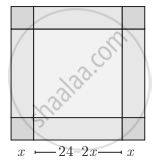Advertisements
Advertisements
Question
If \[f\left( x \right) = \log \left( \frac{1 + x}{1 - x} \right)\] , then \[f\left( \frac{2x}{1 + x^2} \right)\] is equal to
Options
(a) {f(x)}2
(b) {f(x)}3
(c) 2f(x)
(d) 3f(x)
Solution
(c) 2f(x)
\[ = \log \left( \frac{\frac{1 + x^2 + 2x}{1 + x^2}}{\frac{1 + x^2 - 2x}{1 + x^2}} \right)\]
\[ = \log \left( \frac{(1 + x )^2}{(1 - x )^2} \right)\]
\[ = 2 \log \left( \frac{1 + x}{1 - x} \right)\]
\[ = 2 (f(x))\]
APPEARS IN
RELATED QUESTIONS
Find the domain of the function f(x) = `(x^2 + 2x + 1)/(x^2 - 8x + 12)`
Let f : R → R and g : C → C be two functions defined as f(x) = x2 and g(x) = x2. Are they equal functions?
f, g, h are three function defined from R to R as follow:
(i) f(x) = x2
Find the range of function.
Write the range of the real function f(x) = |x|.
If f(x) = cos [π2]x + cos [−π2] x, where [x] denotes the greatest integer less than or equal to x, then write the value of f(π).
Let f and g be two functions given by
f = {(2, 4), (5, 6), (8, −1), (10, −3)} and g = {(2, 5), (7, 1), (8, 4), (10, 13), (11, −5)}.
Find the domain of f + g
Let f and g be two real functions given by
f = {(0, 1), (2, 0), (3, −4), (4, 2), (5, 1)} and g = {(1, 0), (2, 2), (3, −1), (4, 4), (5, 3)}
Find the domain of fg.
If \[f\left( x \right) = \log \left( \frac{1 + x}{1 - x} \right) \text{ and} g\left( x \right) = \frac{3x + x^3}{1 + 3 x^2}\] , then f(g(x)) is equal to
If 2f (x) − \[3f\left( \frac{1}{x} \right) = x^2\] (x ≠ 0), then f(2) is equal to
Let A = {x ∈ R : x ≠ 0, −4 ≤ x ≤ 4} and f : A ∈ R be defined by \[f\left( x \right) = \frac{\left| x \right|}{x}\] for x ∈ A. Then th (is
If \[f\left( x \right) = 64 x^3 + \frac{1}{x^3}\] and α, β are the roots of \[4x + \frac{1}{x} = 3\] . Then,
The domain of the function \[f\left( x \right) = \sqrt{5 \left| x \right| - x^2 - 6}\] is
If f(m) = m2 − 3m + 1, find f(0)
Express the area A of a square as a function of its side s
Prove that alogcb = blogca
Solve for x.
2 log10 x = `1 + log_10 (x + 11/10)`
Solve for x.
x + log10 (1 + 2x) = x log10 5 + log10 6
Select the correct answer from given alternatives.
If log10(log10(log10x)) = 0 then x =
Select the correct answer from given alternatives.
Find x, if 2log2 x = 4
The equation logx2 16 + log2x 64 = 3 has,
Answer the following:
Find x, if x = 33log32
Answer the following:
Show that, logy x3 . logz y4 . logx z5 = 60
Answer the following:
Find the range of the following function.
f(x) = `1/(1 + sqrt(x))`
Given the function f: x → x2 – 5x + 6, evaluate f(x – 1)
A graph representing the function f(x) is given in it is clear that f(9) = 2

For what value of x is f(x) = 1?
An open box is to be made from a square piece of material, 24 cm on a side, by cutting equal square from the corner and turning up the side as shown. Express the volume V of the box as a function of x

The data in the adjacent table depicts the length of a person's forehand and their corresponding height. Based on this data, a student finds a relationship between the height (y) and the forehand length (x) as y = ax + b, where a, b are constant.
| Length ‘x’ of forehand (in cm) |
Height 'y' (in inches) |
| 35 | 56 |
| 45 | 65 |
| 50 | 69.5 |
| 55 | 74 |
Find the length of forehand of a person if the height is 53.3 inches
If the domain of function f(a) = a2 - 4a + 8 is (-∞, ∞), then the range of function is ______
Mapping f: R → R which is defined as f(x) = sin x, x ∈ R will be ______
Find the domain of the following functions given by f(x) = x|x|
Find the range of the following functions given by f(x) = 1 – |x – 2|
Domain of `sqrt(a^2 - x^2) (a > 0)` is ______.
The domain of the function f given by f(x) = `(x^2 + 2x + 1)/(x^2 - x - 6)` is ______.
The domain and range of the function f given by f(x) = 2 – |x – 5| is ______.
Let f(x) and g(x) be two real polynomials of degree 2 and 1 respectively. If f(g(x)) = 8x2 – 2x, and g(f(x)) = 4x2 + 6x + 1, then the value of f(2) + g(2) is ______.
If f(x) = x3 – 1 and domain of f = {0, 1, 2, 3}, then domain of f–1 is ______.
If f: R `rightarrow` R be a function defined by f(x) = 4x3 – 7. Then ______.
lf f : [0, ∞) `rightarrow` [0, ∞) and f(x) = `x/(1 + x)`, then f is ______.
